2015 Rangers Autopsy and 2016 Needs
For fans of the 14 NHL teams that missed the playoffs, there are endless scenarios for improvement headed into the 2015-16 season. Teams that were eliminated in the first or second round have also stirred debate amongst fans as to what can be done to advance further next spring.
But what can be said about a depth-based team of mostly under contract players still in the prime of their careers, that has finished in the top four in three of the last four seasons? What more can be added or subtracted to the New York Rangers, who won the President’s Trophy and made it as far as Game 7 of the Eastern Conference Finals? Teams that come within five wins of the Stanley Cup always have more to lose than gain in the off-season, because the drop is further than the ascent.
Unlike the prior off-season, when the Rangers had key players head into unrestricted free agency including Benoit Pouliot, Anton Stralman, and Brian Boyle (and the complications arising from Ryan Callahan’s pending UFA status and the necessary buyout of Brad Richards), this summer’s UFAs do not present any hard choices, and the cap room will be there to re-sign RFAs unless circumstances become abnormal. For more on that, see my previous post on the Rangers’ 2015 cap situation.
Operating under the not-so-crazy assumption that Derek Stepan and Carl Hagelin can be re-signed within the $9-9.5m range, Jesper Fast and J.T. Miller will be retained on reasonable two-year bridge deals, and that re-signing Martin St. Louis would likely mean the departure of Carl Hagelin or the trade of Keith Yandle, we’re going to look at the Rangers’ decisions for next season.
But first, what went wrong for the 2014-15 Rangers?
The Autopsy
It goes without saying that the regular season was a rousing success. While being a weak possession team, the Rangers were able to secure the league’s best record and home ice advantage throughout the playoffs by having the highest combined 5-on-5 shooting and save percentage in the NHL at 1019 (commonly referred to as SPSv% or PDO).
While many proponents of possession (even-strength shot attempts and unblocked shot attempts percentage for/against, where the Rangers hovered between 49-50%) will point out that high PDO teams typically fall short in the playoffs because these high shot/save percentages tend to be unsustainable in the long run while facing teams in a series, it should be noted that 5v5 SP% is always a stable stat for teams with stable goaltending, such as the Rangers. Henrik Lundqvist is what he is, and it’s been that way for 10 seasons now.
As for shot percentage, outside of a few individuals (such as Kevin Klein), there weren’t many Rangers who shot WAY above their career percentages. In fact, some (notably Rick Nash) returned to their typically high S%. Looking at simple Corsi% (5v5 shot attempts for versus against) and Fenwick% (5v5 unblocked shot attempts for versus against) does not always tell the full story: these stats do not take shot range into account, or a team’s ability to make opposing goaltender’s more active by shooting one-timers, generating rebounds and broken plays by screening and crashing the net, all of which make for better scoring chances. Teams get their shots in different ways, and there is something to be said for teams who dominate center ice using size, strength, and skill (Ducks, Penguins, Kings) versus teams that dominate along the boards and cycle the puck well using speedy wingers and relentless forecheckers (Rangers, Red Wings).
The other thing that the “possession uber alles!” crowd doesn’t tell you is when looking solely at possession stats for the playoffs versus shooting and save percentages (PDO), it is usually the high PDO playoff teams that succeed (Ducks, Blackhawks, Rangers, Lightning finish one, two, three and four in playoff PDO while only the Ducks finished top five in playoff possession). Interestingly enough, these high-PDO playoff teams tend to be strong regular season possession teams. Shooting percentages tend to go down in the playoffs, while save percentages go up, and not surprisingly, as in the regular season, it’s always the teams who find a way to get strong goaltending and timely, accurate shots who win in the playoffs. Shock of the century, right?
So what happened in the playoffs?
Well, the Rangers’ team 5v5 save percentage went up from .931 to .939, good for third highest in the playoffs and highest among the final four teams. Hank did his job, and as we saw, he was even better in elimination games.
Even-strength shot attempt and unblocked shot attempt percentages remained in the 49-50% range as they did in the regular season, while shooting percentage plummeted from 8.8% to 6.7% in the playoffs. For the second straight postseason, Rick Nash was the embodiment of this trend. To this point, Nash has led the playoffs in shots on goal with an outstanding 69, but his regular season S% went from 13.8% to 7.2%.
More on Nash and other individuals later, but let’s stick with the team analysis. Larry Brooks put out a column today calling for the Rangers to increase their toughness, subtly placing the blame on Coach Alain Vigneault by comparing his “turn the other cheek” comment directed at Chris Kreider to AV’s similar message to the 2010-11 Canucks who narrowly lost the Finals to the big, bad Bruins.
This simplistic analysis might be popular with fans who constantly scream “HIT SOMEBODY!” throughout the game, but in both cases, Brooks is dead wrong. First off, anybody who watched the Canucks take a 3-2 series lead in that Finals knew that they blew it for one reason, and only one: Roberto Luongo fell apart. Even in spite of Tim Thomas’ otherworldly play in net for the Bruins, the Canucks win that series with ease if Luongo even played adequate in net after Game 4. It had nothing to do with hits, toughness, or intimidation.
Now let’s fast-forward to the present. In Brooks’ example where during Game 6, Chris Kreider took a penalty by retaliating against Steven Stamkos for a dirty hit on Ryan McDonagh, the Rangers were ahead 1-0 in a game where the team was being badly outshot. Was there a single fan who didn’t hold their breath once that penalty was called? Sure enough, at the tail end of the ensuing power play, Ryan Callahan scored on a breakaway to tie the game.
I get the need to stand up for teammates and show toughness, but considering that the Lightning’s power play conversion percentage was nearly 40% for the series, can you really blame AV for wanting to keep guys out of the box at all costs?
Lack of toughness is not what eliminated the Rangers in seven games in the ECF, nor was it ever a problem during the course of the playoffs. Below is a breakdown of hits per game in each game of all three series, with a W or L noted for the game’s result:
Round 1
Game 1 – NYR 32, PIT 32 W
Game 2 – NYR 25, PIT 21 L
Game 3 – NYR 37, PIT 43 W
Game 4 – NYR 42, PIT 28 W
Game 5 – NYR 36, PIT 28 W
NYR 172, PIT 152 W
Round 2
Game 1 – NYR 34, WSH 32 L
Game 2 – NYR 30, WSH 30 W
Game 3 – NYR 31, WSH 39 L
Game 4 – NYR 31, WSH 37 L
Game 5 – NYR 32, WSH 24 W
Game 6 – NYR 30, WSH 36 W
Game 7 – NYR 32, WSH 26 W
NYR 220, WSH 224 W
Round 3
Game 1 – NYR 30, TBL 18 W
Game 2 – NYR 28, TBL 26 L
Game 3 – NYR 33, TBL 41 L
Game 4 – NYR 30, TBL 32 W
Game 5 – NYR 29, TBL 29 L
Game 6 – NYR 27, TBL 22 W
Game 7 – NYR 29, TBL 25 L
NYR 206, TBL 193 L
The Rangers were 8-5 when they outhit or were even in hits with the opposing team, and 3-4 when they got outhit or were even in hits. The trend seems to be on the winning side, and barely. Of course, when you break it down by series, we beat the only team that outhit us for the series.
Speaking of the Capitals, aka the biggest team in the NHL in terms of average height and weight, and by far the biggest hitting, dirtiest team through the first two rounds, the hits were basically even for that series with the Caps having a negligible four hit advantage. All series long, we heard from announcers and fans, “This is a different Caps team! They play just like the LA Kings! This team is built for the playoffs!” And yet the “turn the other cheek” Rangers went hit-for-hit with them en route to a series win. We also outhit the Penguins, not a particularly tough team but one that made a point of coming after us and making every game a tight-checking, shot-blocking affair. And of course, the Tampa Bay Lightning were a cakewalk in terms of brute physicality, as they are one of the smallest teams in hockey.
I say “brute physicality” because Tampa did manage to wear the Rangers down in another aspect of the game: endurance. It was clear for most of the series, even in our big Games 4 and 6 wins, that Tampa was the fresher, faster, and harder playing team. This was the first time in years that the Rangers met a team in the playoffs that was as fast or faster on skates than we are. In a foot-race competition, it’s anybody’s guess who possesses the faster team. Carl Hagelin, Chris Kreider, Keith Yandle and Ryan McDonagh can absolutely fly, and even resident old guys Martin St. Louis and Dan Boyle were among the league’s fastest in their primes. But it’s how a team uses its speed that counts, and Tampa’s speedy forwards were able to wear the Rangers down by outworking us along the boards, keeping up in the neutral zone, and converging at center-ice in unpredictable breakout formations.
This is why we struggled against Tampa in the regular season, and it’s why we had trouble with the Islanders in the first three games of the season series. But unlike Tampa, the Islanders (and every other NHL team) do not possess a top six that can match the Triplets and Stamkos lines, and the Hedman-Stralman pairing is a nightmare and probably the third best in the NHL behind Doughty-Muzzin and Keith-Seabrook.
Too many times, the Rangers pin themselves against the boards during the breakout, immediately setting up the cycle and looking for shots from the point or at center when lanes are fully clogged up. Given that the clogging/shotblocking intensity increases during the playoffs, it’s no wonder that the Rangers have trouble scoring in the postseason. This problem is often alleviated when our defensemen pinch and join the play, but this can be high risk/reward when facing speedy teams. McDonagh pinches, leaving our slowest D-man Girardi to face a possible odd-man rush, and that that risk is intensified with the Yandle-Boyle pairing. When fans wonder why we don’t shoot enough from the points, well…do you really want Johnson and Palat barreling full-steam ahead at Dan Girardi after a blocked shot creates a fortuitous breakout for Tampa?
It’s not all negative for the Blueshirts. After all, this was a seven game series that saw us fall short by a mere two goals in the deciding game. As tough a matchup as the Lightning present, the Rangers are deadly in their own right. No team in the NHL has the defensive depth that we have, or three defensemen who can join the rush like McDonagh, Yandle, Boyle, and at times, Klein can. Our breakout is a thing of beauty when Stepan, Brassard, and Hayes feed Kreider, Nash, and Hagelin speeding up the boards. Those three forwards routinely embarrass opposing D, but the breakout has to work in a way that specifically utilizes our forwards’ strength.
Nash and Kreider are almost always ahead of defenders coming up the boards, but it’s absolutely crucial that both men cut towards the net instead of pinning to the boards, using their size and strength to protect the puck en route to a direct challenge on the goaltender. Hagelin doesn’t quite have the power to always crash, but he does have a center iceman in Hayes who, unlike Stepan and Brassard, does possess the size and hands to dominate the middle of the ice. Stepan is the type of center you want working off the cycle because he has the IQ to bring together all elements of the play, while Brassard has the shot and creativity to be dangerous off the rush with Zuccarello, a player with the same skill-set.
On the scoresheet, there wasn’t much separating the Rangers and Lightning, and to borrow the football cliche, playoff hockey is a game of inches. Zuccarello was scratched, and McDonagh was hurt down the stretch. A goal here and a save there can make all the difference in the world, and in that context it’s difficult to extrapolate any useful lessons from a tight seven game series.
I think, though, beyond the numbers and game-planning, there was one disappointing trend that reared its head early in the Washington series, and was our ultimate undoing against the Lightning. Simply put, the Rangers lacked battle level and often looked tired late in games, relying on Lundqvist and lucky bounces to bail them out of games they had no business winning. Games 3 and 4 against Washington saw us come out fast and strong, only to fizzle in the final two periods. Stellar play in goal and inspired third period and overtime performances helped us defeat the Capitals. After struggling against the Lightning in Games 2 and 3, Hank was phenomenal in Games 4-7, stealing two games in Tampa where the Rangers were badly outplayed until getting quick offensive explosions in the third period.
In both of their road wins, the Rangers were outshot by wide margins, and out-attempted in the shutout losses at home that saw Ben Bishop, to his ultimate credit, earn two shutouts behind a Tampa defense that didn’t allow a single high quality chance against him. Hank made some of the best stops of his career in Game 7, keeping the score 0-0 for two periods while the players in front of him were repeatedly beat to pucks by the opposition. Aside from Carl Hagelin and the injured Ryan McDonagh, there wasn’t a single forward or defenseman on the Rangers who seemed to have his legs that night. Short of Lundqvist perfection and a lucky overtime bounce, the Rangers were not going to win that game with such an effort.
Seeing Hank bent over in exhaustion and frustration before the start of the handshake line was the image of a franchise player who had given everything and more. Ryan McDonagh had a broken foot stiffened and numbed by freezing agents, according to AV, so he could play the last couple of games. The team’s two prime leaders left everything on the ice. Where was that commitment down the stretch from the rest of the team? This wasn’t a question in the losses against the Kings last year, but it is now. Why? I think the answer lies in the fact that the Rangers ran into a younger, faster team that refused to buckle under pressure like the Capitals and Penguins did. Like so many fallen teams have experienced against us, the Rangers got tired of chasing these guys around.
Who Stepped Up/Who Didn’t
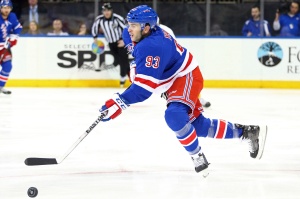
Despite the view among fans, Keith Yandle delivered a playoff performance worthy of the assets it cost to acquire him.
I don’t think that more than a few sentences needs to be written about the regular season. Pretty much everybody stepped up, notably Cam Talbot, Rick Nash, Chris Kreider, Marc Staal, Kevin Hayes, Jesper Fast, Kevin Klein, Derick Brassard and Derek Stepan. Martin St. Louis considerably slowed down after a hot start, Zuccarello played well but struggled to convert on offense, and Ryan McDonagh returned to form down the stretch after injuries impeded his first half. Dan Boyle was a disappointment, while Keith Yandle basically continued his points-per-game pace from Arizona with slightly improved defensive play. Everybody else played to expectations.
But it’s all about the playoffs, and I’m going to single out a few guys here for good and bad.
Nothing more needs to be said about Henrik Lundqvist, who arguably had his best postseason performance this year. The highlight reel saves from 2015 alone are enough to make for an epic YouTube video, and his elimination game dominance continued, even in the ECF Game 7 loss.
Derick Brassard also continued his string of clutch playoff performances, ending with 16 pts in 19 games, along with 9 goals and a +9 rating.
90% of Ranger fans will disagree with my next choice, but Rick Nash had a very good playoffs. Did it match his MVP caliber regular season output? No. Was it a great performance, worthy of the superstar moniker? No. But he was absolutely dominant in two of our three wins in the ECF, and was almost as good the whole first round. The semi-finals is where he struggled the most, and if he managed to score just a few more points there, Nash would have been among the leading playoff scorers this year.
To put this into greater perspective, compare Nash’s 2015 playoff numbers to 2014:
Rick Nash – 2014 Playoffs
GP G A P +/- PIM PPP SHP GW Shots S% Time-On-Ice
25 3 7 10 -1 8 2 0 1 83 3.6% 17:25
Rick Nash – 2015 Playoffs
GP G A P +/- PIM PPP SHP GW Shots S% Time-On-Ice
19 5 9 14 +8 4 3 0 0 69 7.2% 18:30
The performance improvement is clear. Nash was second in team points behind Brassard, led the league in shots through three rounds, doubled his shooting percentage, and took less penalties while playing a minute more per game than last year. Was it a performance worthy of $7.5 million salary? Perhaps not. But Nash’s numbers put in range of other star players like Alex Ovechkin and Ryan Kesler. It wasn’t an “ultimate vindication” type postseason for Nash, but his play didn’t warrant him being the team whipping boy. More often than not, he was part of the solution.
You know who was even better? Keith Yandle. I know, I know, he’s a turnover machine who doesn’t come up with the points when we need them. Except none of that was true during the postseason. Yandle was our most effective offensive defenseman, scoring and assisting on some of the biggest goals of the playoffs. In terms of defense, outside of some bad turnovers against the Capitals, Yandle was mostly solid.
Below is a snapshot of the leading defensemen in 2015 playoff scoring: (click to enlarge)
The number speak loudly in Yandle’s favor. He was third in scoring among defensemen while playing 1:36 less minutes per game than the next lowest minutes-getter on the list, Dan Boyle, who himself is nearly a minute and a half below Sami Vatanen, who is over two minutes below the next player. That’s elite level offensive efficiency from both Yandle and Boyle. But unlike Boyle, who far and away was the Rangers’ worst defensive liability, there was hardly any risk in Yandle’s play away from the puck. At +7, Yandle remained in the top three among all defensemen, while finishing seventh in shots.
That stat doesn’t tell the whole story, since Yandle had a low number of defensive zone starts and was normally paired against the opposition’s weakest lines, but the point is that he was not a liability. When playing without the puck, Yandle was better than adequate, and even found himself paired against better opposition in the first round when Klein was injured. For the start of Game 7, while McDonagh was being treated in the locker room, Yandle was on the first pairing with Dan Girardi. That’s a measure of earned trust. It makes you wonder why Yandle didn’t receive more ice time than Dan Boyle. It’s fair to say that any criticism of Yandle is a result of confirmation bias: fans chose to notice him only when he made turnovers.
On the other hand, Dan Boyle was the embodiment of high risk/high reward during the playoffs. Offensively, he was very good after some crucial shanked shots in the first round. Having him and Yandle contributing the way they did was a luxury, and you could say that the combination of those two, plus McDonagh, gave the Rangers a distinct advantage in offense from the blue-line over just about everyone else in the East. But being -3 against the weakest assignments and hardly any defensive zone starts is atrocious.
His penchant for coughing up turnovers at the blue-line was brutal, and his inability to move the puck up the boards against the forecheck kept the Rangers pinned in their own zone for egregious amounts of time. Boyle’s offensive contributions during a Rangers playoff goal famine was the only thing keeping Matt Hunwick out of the lineup. Coming up on his 39th birthday and a year left on a move-protected contract, one wonders whether the Rangers are better off buying out Boyle’s contract and paying him to play for someone else.
Rounding out the key playoff performers are Dan Girardi, who was miles better than last year, Derek Stepan, Chris Kreider, Carl Hagelin, and the young guys Jesper Fast and J.T. Miller, the latter of whom showed major promise as a potential top six forward next season.
That should mean the end of Marty St. Louis, who was the undisputed worst performer of the playoffs. Not of the Rangers, of the playoffs.
One goal and seven points with a -1 rating in 19 games, with a porous defensive effort to boot represented the low point of Marty’s hall of fame career. Last year, Marty was our second leading playoff scorer behind Ryan McDonagh, and scored in overtime to put us ahead of the Canadiens 3-1 in the ECF. To anyone who questioned the Ryan Callahan trade last year, I would defend Marty to the hilt. This year, not so much (though it’s interesting to note that Cally has also been terrible for his team this year, continuing a career trend of disappointing playoff performances).
On paper, Marc Staal was another disappointment, but it should be noted that for his bad play in the ECF, Staal was great in the first two rounds. Kevin Klein wasn’t the same since returning from injury, Tanner Glass was a non-factor, and Kevin Hayes struggled despite a couple of clutch moments of his own. Hayes can be forgiven on the basis of age and position – for a player who is not a natural centerman, it will take time for him to become a good playoff performer. This year provided him with experience that will give him an edge over his peers next season.
Needs For 2015-16
It all starts with cap management and in-house business. Glen Sather’s first priority should be signing RFAs Derek Stepan and Carl Hagelin to value deals that will allow for moderate cap flexibility. That means farewell, Marty. Second, J.T. Miller and Jesper Fast must be re-signed on inexpensive two-year bridge deals.
Third, Sather must sit down with Dan Boyle and convince him to waive his no-trade clause. Buying out the remainder of his contract (one more year at $4.5m) is also an option, but that would reduce his cap hit to $2.5m for an extra year. While helpful for 2015-16, that extra $2.5m will come back to bite us when Kreider and Hayes become RFA eligible the following season. If Boyle does accept a trade (and a team actually trades for him), part of the cleared space should be spent on bringing back Matt Hunwick in case one of our D prospects aren’t ready to step up.
James Shepherd can walk in favor of Oscar Lindberg, who has been described by Wolfpack watchers as a faceoff winning, defensive menace who can contribute on offense and is NHL ready yesterday. Lindberg was the Wolfpack’s second leading playoff scorer during their own run to the conference finals in the AHL.
Another young player who is ready to step up is Carl Klingberg, ho can provide big size and nasty physical play in a bottom six role. He could be the first call-up in case of trade or injury.
In the aforementioned Larry Brooks article, he mentions the need to bring Dylan McIlrath into the fold on defense to provide toughness. There isn’t a Rangers fan on earth who doesn’t want to see McIlrath, the 10th overall pick in 2010, make the team and succeed long-term. The issue, as always, is whether or not he’s ready. There hasn’t been a lot of feedback on McIlrath, positive or negative, except that he’s coming along slowly and needs to work on his skating and defensive positioning. On the other hand, Brady Skjei, our top defensive prospect, is a speed demon with a hard shot who is earning rave reviews for his defensive play in the AHL. This article from Hockey’s Future provides insight into the current development status of both McIlrath and Skjei.
Next season, barring a buyout or trade of Dan Boyle, or a significant injury, the only opening on defense will be at the number seven spot. In this role, a player will see anywhere from 20 to 30 games at most. If it’s true that McIlrath is incapable of playing left defense, that means he’ll have to wait until Dan Boyle is gone to compete for a regular spot. As for Skjei, his speed and defensive attributes are much better suited to an evolved NHL that values speed, awareness, possession and playmaking over hitting and crease-clearing. McIlrath can absolutely be valued as a hitter, but he can’t play at the pro-level without some of the finer skills in his repertoire. After all, based on the above descriptions of McIlrath and Skjei, who do you think would have benefitted the Rangers more against the Lightning?
Mat Bodie, Conor Allen, and the hulking Ryan Graves will also be competing for defensive spots this year and next. Graves possesses all the gritty aspects of McIlrath, along with the size, which could ultimately lead to McIlrath’s trade.
The best scenario is that Skjei and McIlrath, or the two best defensive showings in camp, spend time alternating as the 7th D, playing in the range of 15 games each, with the better of the two replacing Dan Boyle when he departs in summer 2016 (and possibly both making the team if Keith Yandle also leaves).
As for the rest of the team, it will be up to the young core to turn the dial up while Henrik Lundqvist, Rick Nash, Dan Girardi, and Marc Staal are still in their primes. There could be anywhere from a three to five year window until these players begin to rapidly decline, but until that happens, expect the Rangers to remain at the top of the league in terms of Cup competitiveness.
Unlike years past, there is no trade or free agency option that will make this team better. All needs are currently filled, it’s just a matter of the young players getting better. Fortunately, team leaders Ryan McDonagh, Derek Stepan, Derick Brassard and Mats Zuccarello still have room to grow and improve, while Chris Kreider, Kevin Hayes, J.T. Miller and Jesper Fast are in the infancy of their careers and could potentially be twice what they are now. McDonagh must take the next step and bring his offense up to the level of players like Duncan Keith and Drew Doughty. Hayes and Stepan will have to become reliable faceoff winners. Kreider can be a premiere power forward with unmatchable athleticism if he can bring a consistent effort over 82 games.
The key for the Rangers, the difference between winning or not winning a Cup in these next three years, will be the continued upward trajectory of these players. Best of all, the Rangers’ cap situation should not prevent us from retaining every single one of them, as only Stepan, Kreider, and Hayes remain to be signed long term with key veteran contract expirations on the horizon.
As prospects continue to graduate to the big club, and with Brady Skjei and Pavel Buchnevich as the only consensus Top 50 prospects in our system, the Rangers must explore trades to replenish lost draft choices. Cam Talbot can be used to gain a high second or low first round draft choice this June, and if a reasonable deal can’t get done with Keith Yandle, he would net a very good return at next year’s trade deadline. If Yandle continues to play well and if Kevin Klein regresses, Klein’s salary is very cap friendly and could probably get us a first round pick in return. This all depends on the rapid development of Brady Skjei or Dylan McIlrath, but trading Klein opens up enough salary to keep Yandle along with our 2017 RFAs.
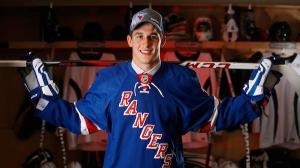
Brady Skjei might be the next homegrown Rangers defenseman, following in the footsteps of Dan Girardi and Marc Staal.
Projected 2015-16 Rangers Depth Chart:
LW C RW
Nash Brassard Zuccarello
Kreider Stepan Miller
Hagelin Hayes Fast
Glass Moore Lindberg
LD RD
McDonagh Girardi
Staal Klein
Yandle Boyle
Goalie
Lundqvist
Skapski
13th Forward: Klingberg
7th Defenseman: Skjei
Posted on June 1, 2015, in Uncategorized and tagged 2015 NHL Playoffs, 2015-16 NHL Season, Brady Skjei, Carl Hagelin, Carl Klingberg, Chris Kreider, Dan Boyle, Derick Brassard, Dylan McIlrath, Glen Sather, Henrik Lundqvist, J.T. Miller, Keith Yandle, Larry Brooks, Martin St. Louis, New York Post Rangers, New York Rangers, Oscar Lindberg, Rangers Needs, Rick Nash, Ryan McDonagh. Bookmark the permalink. 6 Comments.
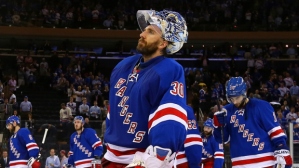

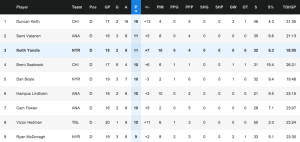
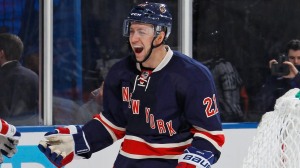
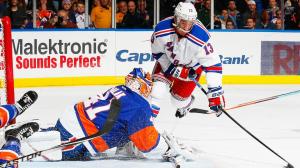
It didn’t come out very legible. Sorry about that. The copy & paste failed from Excel. In any case, I am showing 72.45 using your roster and signing amounts. If you’d like me to re-post it again in a more legible form, I can do that.
LikeLike
No problem. Your numbers come out to $72.15 when you consider that Nash is actually a $7.5m annual cap hit for next season, not $7.8. I should also mention that my projection in the initial post about the salary cap has the Rangers carrying 22 players, and presumably leaving either the 13th forward or 7th D in Hartford until needed, wherein the other extra player would then be sent back down. So that is an additional 72k-90k off the cap hit, depending on who gets sent down.
So while my projection does not provide exact math (nor can it, given that we don’t know what guys will be signing for) additional $400-600k is easily manageable. It could come from a Hagelin and/or Stepan discount, a trade involving Tanner Glass or Dom Moore, or the acquisition of a goalie cheaper than Skapski’s minor league salary. There is also the option of buying out Dan Boyle at a cap hit of half his annual salary spread over two years, or as I mentioned in the post, the last ditch option of trading Yandle. All told, the Rangers really aren’t in that rough of a position, and can certainly afford to keep their young players. If room must be made, it won’t be Kreider/Hayes/Stepan/Hagelin/Miller/Fast, etc, who will be moved to accommodate.
Once again, thanks for the comments! It’s always refreshing to intelligently discuss hockey with someone.
LikeLike
Just read the last article, Will. It’s a good read, but I can’t get your numbers to work. Here is what I come up with … using your projected roster:
Left Wing Center Right Wing
Nash 7.800 Brassard 5.000 Zucc 4.500
Kreider 2.475 Stepan 6.000 Miller 1.100
Hagelin 3.000 Hayes 0.900 Fast 1.100
Glass 1.450 Moore 1.500 Lindberg 0.750
Left Defense Right Defense Goaltending
McDona 4.700 Girardi 5.500 Lundqvist 8.500
Staal 5.700 Boyle 4.500 Skapski 0.800
Yandle 2.625 Klein 2.900
13th F & 7th D
Total Salary Klingbrg 0.750
72.450 Skjei 0.900
I hope the above comes out so that it is readable. You are about 1.5 mil over the 71 mil cap and you probably want at least .5 in operating cash….so I’d say we have to find a way to drop 2 mil off the roster.
LikeLike
Nice article, but your projected line-up for 2015-16 cannot possibly work. You’re over the salary cap…maybe by as much as 2 mil or so. Not only do we need to meet the cap, we’ll need a bit of operating space.
Time for Rangers fans to admit there will be a major trade or two. Not just Talbot. Either Hags or Klein will be traded (or both), unless they shock everyone and are able to talk Boyle into a trade and someone is willing to take him. Might see someone else traded that we didn’t exect.
In any case, something is going down.
LikeLike
Thanks for the reply, Christian! Check out my previous article that goes in depth with cap numbers. Using a projected cap of $71m, I explain how the Rangers can bring back most of the current roster, even beyond next season. It’s a lot more fleshed out than the numbers I alluded to in the above article. Let me know what you think!
LikeLike
Excellent article very in depth your right on about Nash and yandle
LikeLike